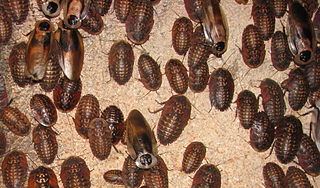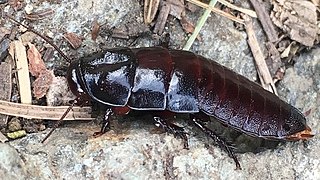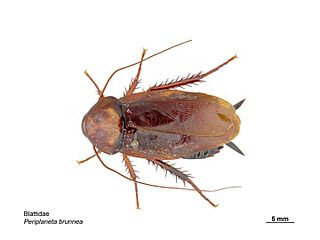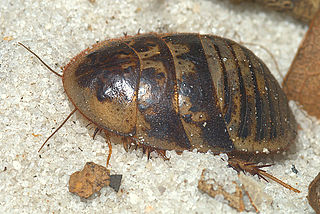
Bookworm is a general name for any insect that is said to bore through books.

Dictyoptera is an insect superorder that includes two extant orders of polyneopterous insects: the order Blattodea and the order Mantodea (mantises). All modern Dictyoptera have short ovipositors and typically lay oothecae. The oldest fossils of Dictyoptera from the Late Carboniferous, referred to as "roachoids" have long ovipositors and did not lay oothecae. The oldest modern oothecae-laying dictyopterans date to the Late Triassic.

Giant cockroaches, or blaberids, are the second-largest cockroach family by number of species. Mostly distributed in warmer climates worldwide, this family is based on the American genus Blaberus, but much of the diversity is also found in Africa and Asia.

Blattidae is a cockroach family in the order Blattodea containing several of the most common household cockroaches. Notable species include:

Cryptocercus is a genus of Dictyoptera and the sole member of its own family Cryptocercidae. Species are known as wood roaches or brown-hooded cockroaches. These roaches are subsocial, their young requiring considerable parental interaction. They also share wood-digesting gut bacteria types with wood-eating termites, and are therefore seen as evidence of a close genetic relationship, that termites are essentially evolved from social cockroaches.

The brown cockroach is a species of cockroach in the family Blattidae. It is probably originally native to Africa, but today it has a circumtropical distribution, having been widely introduced. In cooler climates it can only survive indoors, and it is considered a household pest.

Blattodea is an order of insects that contains cockroaches and termites. Formerly, termites were considered a separate order, Isoptera, but genetic and molecular evidence suggests they evolved from within the cockroach lineage, cladistically making them cockroaches as well. The Blattodea and the mantis are now all considered part of the superorder Dictyoptera. Blattodea includes approximately 4,400 species of cockroach in almost 500 genera, and about 3,000 species of termite in around 300 genera.

Cockroaches are insects belonging to the order Blattodea (Blattaria). About 30 cockroach species out of 4,600 are associated with human habitats. Some species are well-known as pests.

The emerald cockroach wasp or jewel wasp is a solitary wasp of the family Ampulicidae. It is known for its unusual reproductive behavior, which involves stinging a cockroach and using it as a host for its larvae. It thus belongs to the entomophagous parasites.

Arenivaga is a genus of sand cockroaches, of the subfamily Corydiinae, in the family Corydiidae. These cockroaches live in sandy soils and dunes in the southwestern United States, Florida and Mexico. Arenivaga comes from the Latin arena meaning sand and vagus meaning wandering.

Archimylacris is an extinct genus of cockroach-like blattopterans, a group of insects ancestral to cockroaches, mantids, and termites.

Periplaneta is a genus of cockroaches.

Diploptera, occasionally called beetle cockroaches, is a genus of blaberid cockroaches in the monotypic subfamily Diplopterinae. Cockroaches of this genus resemble beetles, with hardened tegmina and cross-folded hindwings. They live in tropical forests in South China and Southeast Asia, and Pacific islands including Hawaii. They are viviparous cockroaches and are therefore used for insect endocrinological studies.

Therea petiveriana, variously called the desert cockroach, seven-spotted cockroach, or Indian domino cockroach, is a species of crepuscular cockroach found in southern India. They are members of a basal group within the cockroaches. This somewhat roundish and contrastingly marked cockroach is mainly found on the ground in scrub forest habitats where they may burrow under leaf litter or loose soil during the heat of the day.
Blattabacterium is a genus of obligate mutualistic endosymbiont bacteria that are believed to inhabit all species of cockroach studied to date, with the exception of the genus Nocticola. The genus' presence in the termite Mastotermes darwiniensis led to speculation, later confirmed, that termites and cockroaches are evolutionarily linked.

Ectobius is a genus of non-cosmopolitan cockroaches once thought native to the Old World and described by Stephens in 1835, belonging to the family Ectobiidae, subfamily Ectobiinae. The discovery of 4 ectobius cockroaches in Colorado dating to 49 million years ago suggests the genus actually originated in North America. This genus has been subject to a number of revisions.

Saltoblattella montistabularis is a species of jumping cockroach, in the tribe Baltini known only from Table Mountain near Cape Town, South Africa. Both the species and genus were newly described in 2009. Researchers nicknamed the species leaproach. Its jumping mechanism is similar in anatomical features and in performance to grasshoppers with which it shares its habitat. Like grasshoppers, it is able to jump between grass and sedge stems. Its ability to jump is unique among the approximately 4,000 known species of cockroaches. Since the discovery and description of S. montistabularis in 2009 at least 2 more species have been discovered - one from the Cape Cederberg, one from Bredasdorp and a third with black and white stripes from Mossel Bay and Nature's Valley. All these are in the fynbos belt along the southern Cape coast.

Gromphadorhina is a genus of large, flightless cockroaches from southern Madagascar; they are typical of the tribe Gromphadorhini and common in the pet trade. In the older literature, the name is sometimes misspelled as Gromphadorrhina.
Blabericolidae is a family of parasitic alveolates in the phylum Apicomplexia.

Schizopilia fissicollis is a species of cockroach living in Suriname and French Guiana.


















